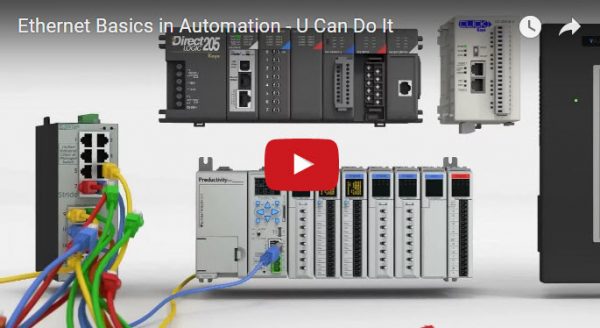Ethernet has become a prominent method of communication in industrial automation. Its ease of use, speed, and versatility have allowed it to surpass the older, closed-off, proprietary means. Not only that, but Ethernet has also introduced automated systems to a whole new world of possibilities with connections to high-level IT systems, remote/mobile access, cloud computing, smart devices, etc. Along with its many advantages, Ethernet also has a few disadvantages. For one, it’s not deterministic which is bad for real-time process control and safety systems. However, as with any technology, Ethernet has advanced and will advance over time to compensate for these shortcomings and will further cement its position as a dominant network standard.
For now, Ethernet provides three main data transmission speeds. Standard Ethernet is able to transmit at 10Mbps (10BASE-T), Fast Ethernet can handle 100Mbps (100BASE-T) and Gigabit Ethernet’s transmission rate is 1000Mbps (1000BASE-T). Even faster speeds are possible, although not practical, with 100Gbps being the current maximum and 200Gbps and 400Gbps being a possibility in the near future. These extremely high Gigabit speeds require special links but for the three commonly used speeds, twisted pair copper cables (Cat 5 cables or better) is currently the transmission link of choice. Other topology options include fiber optic connections, which provide for better electrical isolation and longer distances, and industrial Ethernet switches which can improve the overall efficiency of the Ethernet network.
Ethernet also has the ability to communicate using multiple protocols on the same network. Many industrial Ethernet communication protocols exists including EtherNet/IP, Ethernet TCP/IP, Modbus TCP/IP and Profinet. With Ethernet networking, all of these protocols can reside on the same network at the same time. However, in the U.S., EtherNet/IP and Modbus TCP are the most used Ethernet protocols and it is common for PLCs and other control devices to support one or both.
As industrial automation devices advance and offer more data at faster rates, so too will the industrial networks they use to send/receive this data. Ethernet is currently providing the speed and bandwidth that is needed for many modern-day applications. Virtually every brand of PLC, HMI, and SCADA hardware now includes models with built-in Ethernet ports and Ethernet protocol support. If you would like to know more about Ethernet basics such as how to use Ethernet with our collection of Ethernet-enabled controllers, check out our newest chapter on Ethernet Basics in the Automation VIDEO Cookbook. There you’ll find many informative videos that discuss topics such as:
- How to connect to a CLICK, Do-more, or Productivity series controller via Ethernet
- How to use Ethernet port forwarding with our PLCs
- How to connect remotely to a PLC behind a VPN router
(Click on the image above to watch the Ethernet Basics in Automation video or click here: Ethernet Basics)
Ethernet is being used more and more to establish communications between all of our various automation devices. So coming up to speed quickly with Ethernet is becoming really important. The good news is when it comes to Ethernet Basics, You Can Do It…with AutomationDirect!



